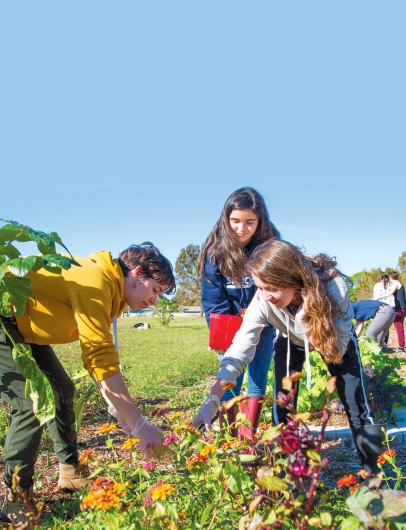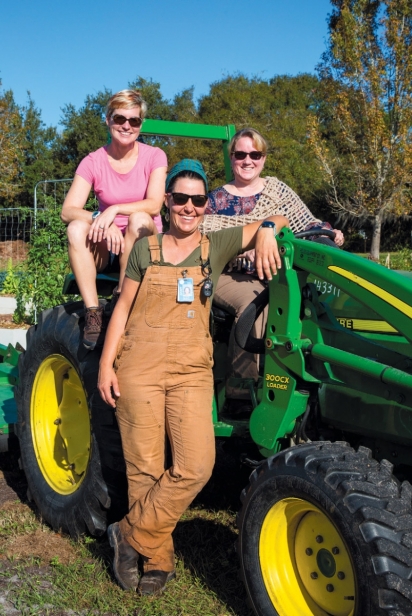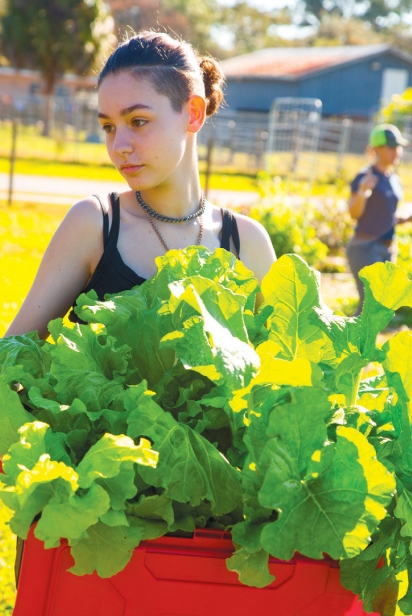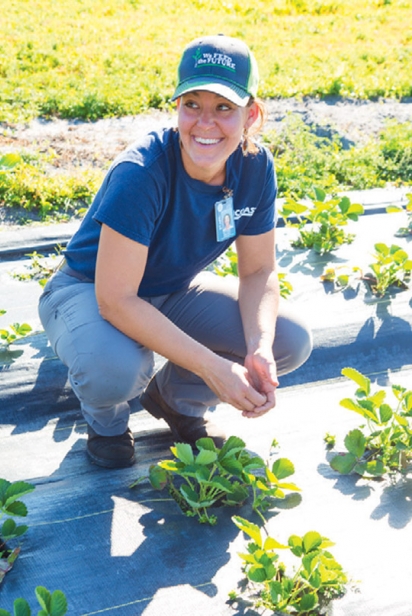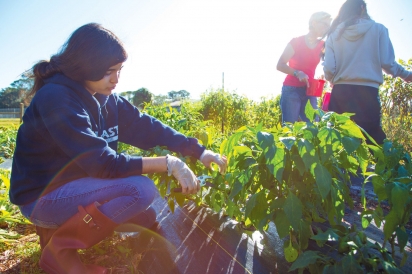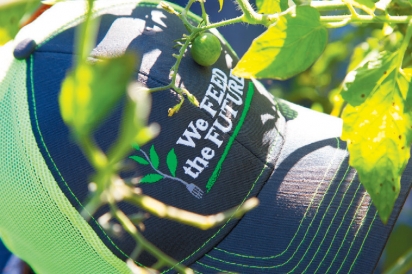Growing for the Future
Sarasota Edible Schoolyard
Farming is about the future—and that couldn’t be more true than with the new farm program underway at Sarasota County Schools.
Sarasota County Schools already has several ties to Florida farming. It frequently buys products from many state-based farms, including Palmetto Acres in Arcadia, Jones Potato Farm in Parrish, Homestead Hydroponics in Myakka City, M&B Products in Tampa, Miami Beef in Hialeah, and many others.
There also are 31 Sarasota public schools with school gardens.
Yet the latest farm project, made possible with the help of a $100,000 grant from the U.S. Department of Agriculture (USDA) and $75,000 from the Florida Department of Agriculture and Consumer Services, gives the concept of farm-to-school new meaning.
In a space that’s just a little under five acres adjacent to McIntosh Middle School on donated land, Sarasota Schools is using the grant money to grow a diverse array of produce that will be used in the cafeteria and as part of tastings with students. The farm itself also will be used for student field trips to expose children to farm careers, healthy eating, and sustainable living.
On the farm tract, we’re not just talking a row of lettuce here and a few tomato plants over there. Farm-to-school liaison Kate Traugott, along with students from Suncoast Technical College, have planted literally dozens of produce items—some you may have heard of, and some that may be completely new. Everything has been planted since this past summer.
Figs. Avocados. Loquats. Four types of mango, one named Cotton Candy. Lychees. Sapodilla. Tomatillos. Okinawa spinach. Roselle. Tomatoes. Strawberries. Carambola, also known as star fruit. Longans. Okra. African blue basil. Kale. Cucumber. Nopales. Banana. Dragon fruit. We could go on.
One goal was to find items to grow that would compliment the school system’s solid relationships with regional farmers, says Carrie McDonald, farm-to-school coordinator for Sarasota County Schools.
Traugott, who’s a farmer and a master naturalist, can talk in detail about everything that’s grown, how it grows, its purpose, and when it’ll be ready for harvest. If you see something that looks unfamiliar, just ask. Take for instance that longer zucchini-looking plant that’s hanging—it’s actually a luffa, but you probably know it as loofah. Yes, a loofah like you might use when taking a bath or shower.
The plants are organized among traditional crop rows, in raised beds, and as part of a half-acre food forest. (A food forest features edible plants that eventually grow to different sizes, providing biodiversity and ultimately helping each plant to yield more.) Each area of the farm is thoughtfully designed to foster better growth. The diversity on-site also ensures a greater chance for success, Traugott says.
Another consideration for designing the farm is climate change, which likely will continually shift what can or can’t be grown in the Sunshine State, including the Sarasota schools farm, Traugott says. That’s one reason why there’s less emphasis on traditional Florida-grown citrus and a greater focus on lesser- known produce that may eventually become more common.
The farm’s setup also helps to serve as a model for the school system’s various school gardens. One goal for the farm project is for staff and students from the district schools to be able to visit the farm and learn. This is part of the farm’s overarching mission to be used as a teaching tool, says Sara Dan, director of Food and Nutrition Services for Sarasota County Schools.
With 54 schools in the Sarasota public school system, the farm likely won’t to provide large-scale produce quantities to all of the schools. Instead, the farm’s harvests will expose students as often as possible to a wide range of produce items. For example, Okinawa spinach could be added as an extra to the traditional lettuce for salads.
The school system also has food ambassadors who help devise fun tasting events for students. There already has been a tasting event with a harvest of figs and star fruit during My Florida Plate day in early October. “We had some very positive feedback,” McDonald says. Introducing new foods can take a little creativity as not all students are eager to try something new.
Another puzzle piece that’s part of the farm project is the use of the Suncoast Technical College students who volunteer at the farm on Mondays. However, those helping out on the farm aren’t just students who have a bent toward agriculture. Some are plumbing students who helped design irrigation for the tract of land. Others are trades-oriented students who have designed farm tools.
In addition to help from Suncoast, other contributions have included 1,000 strawberry plants donated by the Gulf Coast Research and Education Center in Ona.
Dan also hopes that exposure to the farm and what’s grown there will inspire children and young adults to think about careers in agriculture. “There are great careers. There are a lot of opportunities here to learn about food, growing, nutrition, and what’s sustainable,” says Dan, who was part of 4-H and National FFA Organization while growing up.
Learning the thoughtful steps involved in growing food—and even doing tasks like reading a seed packet—are important skills but often lost on many kids today, McDonald says. “This area used to be more farm-oriented. This gives us a chance to bring back some of those skills and values,” she says.
Naturally, the exposure to more produce also is meant to encourage healthier eating. For instance, it’s not just about carrots or lettuce but an array of healthy produce choices that kids may grow to love.
School system farm projects and edible school gardens continue to crop up around Florida and across the U.S. To help get further guidance, Traugott and Food and Nutrition Services Food Ambassador Katelyn Grimmett were able to attend a workshop with chef and author Alice Waters called the Edible Schoolyard Project, held in Berkeley, California, this past summer. “It was amazing,” Traugott says. “We were able to connect with people doing this type of work all around the country.”
The USDA $100,000 grant also has the objective of establishing produce grown in Florida as 50% of the Sarasota district’s produce budget.
Florida farm-to-school purchases had a $144.7 million economic impact in the 2018–19 school year, according to a report from the Florida Department of Agriculture and Consumer Services.
School Gardens
Alta Vista Elementary School
Atwater Elementary School
Bay Haven Elementary School
Brentwood Elementary School
Cranberry Elementary School
Englewood Elementary School
Fruitville Elementary School
Garden Elementary School
Glenallen Elementary School
Gocio Elementary School
Gulf Gate Elementary School
Heron Creek Middle School
Lakeview Elementary School
Lamarque Elementary School
Laurel Nokomis School
Oak Park School
Phillippi Shores Elementary School
Pine View School
Southside Elementary School
Toledo Blade Elementary School
Tuttle Elementary School
Venice Elementary School
Venice High School
Wilkinson Elementary School
Gardens that supply the cafeteria
McIntosh Middle School
Booker Middle School
Sarasota Edible Schoolyard
Coming soon
Sarasota High School
Riverview High School


